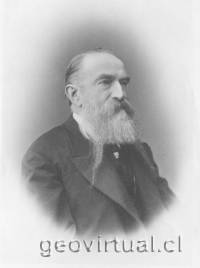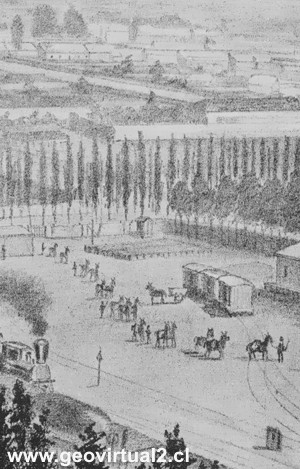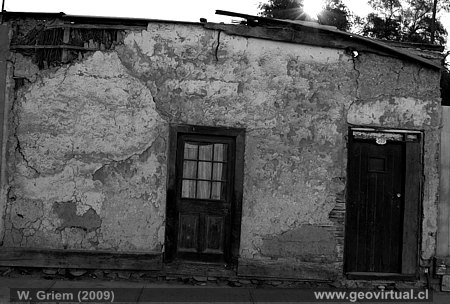Paul Treutler (info)
Content
Pictures
Annotations
Text of Treutler
---
page +

-------1--------
"and consisted of a large dining room and about eight guest rooms, but
neither the former nor the latter had windows; they received their light
only through the doors"
This style can be observed until today in some older hotels or residential,
especially in Vallenar and Copiapó..
------2-------
"As soon as the news had spread that a German had arrived, the compatriots
already living here appeared to greet me. It was Mr. Georg Huneus, mining
owners, Felix Engelhard, Louis Schnakenberg and Adolph Schwarzenberg, all
three mountain engineers from Cassel, Wilhelm and Herrmann Schmidt, merchants
from Hamburg, David Levingston, pawnbrokers from Poznan, Horace Lutschannig,
chemists from Trieste, and the mine owners living near here, brothers Erdmann
from Waldenburg (Silesia),also mine owners"
see:
Georg
Huneus
Felix
Engelhard
Louis Schnakenberg
Adolph Schwarzenberg
Herrmann Schmidt
Wilhelm Schmidt
David Levingston
Horace Lutschannig
Hermanos Erdmann
-------3-------
"without the slightest vegetation and covered with sand and debris, while its
rocky peaks towered over a thousand feet in picturesque shapes"
The hills around Copiapó are between 700m to 1000m high, the city is located
between 350m to 450m above sea level..
--------4--------
"In view of this terrifying phenomenon, there were very few two-storey
or brick houses"
Philippi describes the opposite during his visit in 1853:"Copiapó has many
beautiful and picturesque houses, many two-storey houses despite the high
frequency of earthquakes."." (see)
-------5---------
"18 de Septiembre cual se celebran a honor de la declaración
de independencia de España en which was celebrated on 18 September to commemorate
the declaration of independence from Spain in 1818"
Treutler was wrong here: Right it would be: September 18,1810..

From: Paul Treutler (1882)
See Pictures of Atacama
The original texts were digitized, converted to ASCII and edited by Dr. Wolfgang Griem. Sketches and drawings are digitally cleaned.
Literature: Copiapó in 1853 - 1856
Description of Copiapó by Paul Treutler in
1853-1856. It doesn't always coincide with reality.
Original Text:
From the train station I drove to the recommended guest-house
"Hotel de Comercio", which was owned by an Italian named Menelli, and fortunately
I found accommodation there. This hotel was an old dilapidated building
built only of Adobe (clay bricks) and consisted of a large dining room and
about eight guest rooms, but neither the former nor the latter had windows;
they received their light only through the doors (1), so that in order not
to be in darkness on the bright day, one had to either burn light or leave
the door open, which was due to the many Mosquit- As soon as the news had
spread that a German had arrived, the compatriots already living here appeared
to greet me. It was Mr. Georg Huneus, mining owners, Felix Engelhard, Louis
Schnakenberg and Adolph Schwarzenberg, all three mountain engineers from
Cassel, Wilhelm and Herrmann Schmidt, merchants from Hamburg, David Levingston,
pawnbrokers from Poznan, Horace Lutschannig, chemists from Trieste, and
the mine owners living near here, brothers Erdmann from Waldenburg (Silesia),also
mine owners who were my childhood friends (2). We stayed together
until late into the night. (...)
As soon as I fell asleep, woke up to a rather unpleasant noise, mice took
up my bed and moved with great familiarity on top of the blanket, I felt
strong itching everywhere on my body and discovered that the bed was full
of bugs. After sending the mice where they came from and covering the caves,
I covered the whole bed with a layer of insecticide powder and went to bed
to sleep very deep.
(...)
My hotel was close to the river, but here it formed a 300 feet (100m) width
and 1,500 feet (500m) long swamp covered with 12-18 feet (3,60m to 5,40m)
of reeds. After we had crossed this on a screeched embankment, we found
ourselves at the foot of the steep mountain range south of the city, whose
slopes were bare, without the slightest vegetation and covered with sand
and debris, while its rocky peaks towered over a thousand feet in picturesque
shapes (3).
From this "Alameda", the main part of the city stretched eastwards in four
parallel straight-lined streets. The centre of the town was a large square,
with the main church on its western side and the government building, barracks
and prisons on the opposite side. In the middle of the square there was
a bronze statue, representing a miner with a mallet and iron in his hand,
which was erected in honour of a miner Juan Godoi, who discovered in 1832
the silver mining district of Chañarcillo, which was so rich in silver mines,
and yet, like some famous men of Europe, died in distress and misery.
At the railway station you could see a large number of high heaps of silver,
gold and copper ores, where the mine owners and metal buyers had probably
built up their defeats. Here there was always a busy life, with trains of
muzzles loaded with ores loaded with ores from the steep mountain slopes
moving down to this place, on the other hand large rows of wagons with metals
arrived and many people were busy loading ores into the railway wagons to
send them to Caldera.
From the train station there was a beautiful avenue of Italian poplars running
from one mountain range to the other through the valley. "Alameda", i. e.
a public walk where on Sundays military music played and the inhabitants
of Copiapo were looking for refreshment in the shade of the trees.
(...)
Arriving at the foot of the mountain, we visited the Copiapo cemetery, which
was adorned with several beautiful monuments, and from there we returned
to the town from the path that had been heaped up by the swamp.
All the streets were made up of closed rows of houses, while to the rear
there were gardens that offered the inhabitants a place of refuge in the
earthquakes that were so frequent and where they always fled at the first
symptoms of such an earthquake. In view of this terrifying phenomenon, there
were very few two-storey or brick houses (4); they were only built from
clay bricks and most of the walls were built on a wooden frame connected
with palm bark and smeared with wet earth, and the roofs were made from
tied reeds, on which such a layer was also painted. In most of the houses
there were no windows, but only doors which were kept open to allow light
to enter the interior. All the houses were painted white and had to be repainted
every year, in accordance with the police regulations, before the great
Independencia festival, which was celebrated on 18 September to commemorate
the declaration of independence from Spain in 1818 (5). With the cloudless
sky and the rays of the sun shining all the time, the eye became very incommodirt,
and this was made worse by the fact that part of the streets were not paved
and the wind often whirled up thick clouds of dust from the earth, which
was swarming with salt and limestone.
Since every drop of water was of great value here, a lot of officials were
employed to monitor it and distribute it to the individual plots of land,
and there was a canal on each plot of land with a lock; water theft is severely
punished drinking water is brought into the houses in barrels on donkeys
-
A proof of the civilization of this city was absolutely necessary that they
were all lit by gas, paved and paved with pavement and paved with pavements.
(...)
There were very few amusements and diversions in Copiapo; there was only
a coffee house in the suburb of Chimba, the old Grandi, a former member
of the Italian opera house, which carried the name Tivoli; furthermore,
a theatre quite good for Copiapo.

Old house today in Copiapó - Large scale
Books
History of Atacama
Virtual Atacama

Content Copiapó
La Plaza (town square)
Hitos turísticos
Museo Mineralógico y
Regional
La UDA
Estación ferrocarril
Cronología de Copiapó
Textos históricos
Darwin in Copiapó (1835)
I. Domeyko y Copiapó (1840)
Treutler in Copiapó (1853)
►
Treutler - Copiapó (1853)
Gilliss, Copiapó education (1853)
Philippi en Copiapó (1853)
Pérez Rosales Copiapó (1859)
Tornero Copiapó (1872)
Hugo Kunz at Copiapó 1890
Enrique Espinoza - Copiapó
Ramírez, Copiapó 1932
Terremotos:
Burmeister: Terremoto (1859)
Imágenes del pasado: Copiapó
Copiapó hoy y Ayer
Hoteles -
Donde Comer
Mapas
Cifras y estadísticas
Paul Treutler
Intro Treutler in Atacama
Paul Treutler in Copiapó
Paul Treutler en Caldera
viaje Ferrocarril por P. Treutler
Treutler: Accidente ferroviario 1853
Treutler
en Tres Puntas
en Salvadora (Tres Puntas)
accidente en Tres Puntas
carta de Atacama
Terremotos (general)
Terremoto en Tres Puntas, Atacama
Visitantes de Atacama
Listado de Visitantes
R.A. Philippi en Atacama
Paul Treutler in Atacama
Gilliss in Atacama
Charles Darwin, Atacama (1835)
Ignacio Domeyko y Copiapó
Kunz en Copiapó
Hugo Kunz en Chañarcillo
Gilliss Mineros en Chañarcillo
Información adicional
Cronología histórica de la Región
Minería de Atacama
Railroad history of Atacama
Cartas y Mapas de Atacama
Cartas históricas de Atacama
Listado de personajes de Atacama
El sector Copiapó
Viaje al valle interior
Paso San Francisco
Ruta a - Diego de Almagro
La Panamericana
más rutas de Atacama
